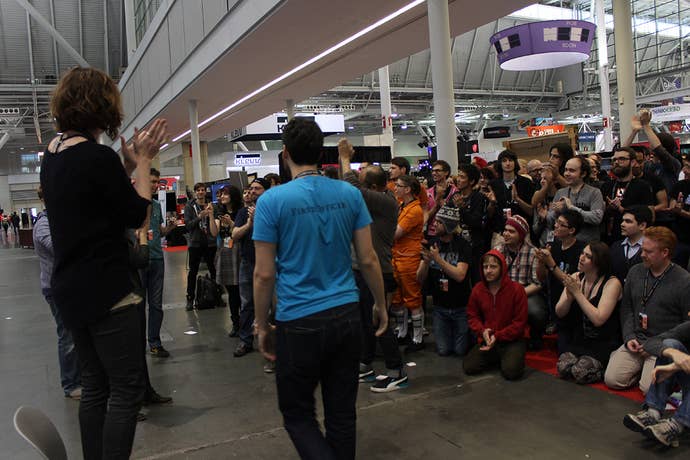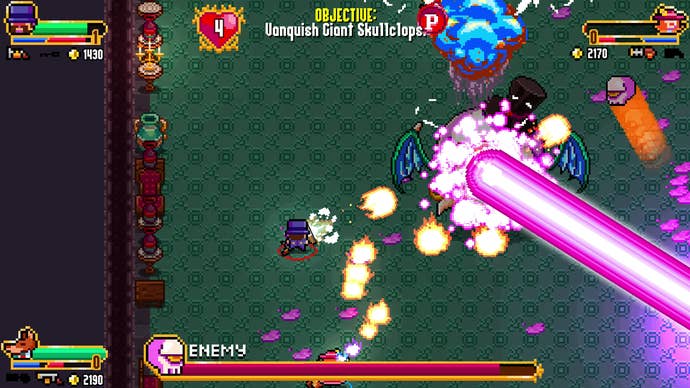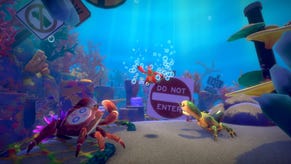With Indies More Prevalent Than Ever, the Indie Megabooth Finds New Ways to Evangelize
How Kelly Wallick's Indie Megabooth has shifted from evangelizing to curating for the indie game development community in a post-bubble world.
This article first appeared on USgamer, a partner publication of VG247. Some content, such as this article, has been migrated to VG247 for posterity after USgamer's closure - but it has not been edited or further vetted by the VG247 team.

Curating a community
Wallick never really thought she would be a tastemaker. Before getting into games, she thought of curation as something reserved for museums or music. But that is more or less her role with the Megabooth, both for games and for the studios that make them.
That role is reflected in the booth itself. "We try to show what's happening in the indie scene. Even the size of the booth, whether something looks super lo-fi one year, or is it very artsy, or are there are fog machines and lights and all these other crazy things. It's sort of like we're letting what's happening in the community drive what we're doing to some extent, even though there's still the same basic foundation."
The Indie Megabooth typically runs two submission sets per year and receive around 250 to 300 submissions each time. Wallick goes through the submissions with Chris Floyd, who is the group's only other full-time employee. She estimates that on average the pair of them play 500 to 600 unique games per year.
Asked what's 'in' right now, Wallick offers a concise picture of what developers are making right now, "There are a lot of what I call 'Star Trek simulators,' this idea of exploring the universe. Local multiplayer for a while was pretty big, and now it's tapering down a little bit, but it's getting down to a very refined and interesting point. We're seeing a lot less endless runners and a lot less puzzle platforms because that's become such a saturated space.There are a lot of bright colors and a lot of sort of playful things - things like toys almost instead of a game."
In selecting games, Wallick sees herself as not only reflecting the trends in indie development but as serving as a kind of shepherd for the community. Her ideal process has developers starting with the Indie Megabooth, but then eventually going on to bigger and better things: "We limit them to three showings. We do it to make them think about how they're marketing their game, that sort of thing," she says.
Wallick also focuses on the companies themselves. "We want to make sure they're contributing positively to the community as a whole, that they would benefit from the mentorship they would get from other teams or the networking, or they could give back in a way where they could be mentors for younger developers," Wallick says. "We had a team of girls that had made a game that they couldn't get school off on a Friday so they had to show on Saturday, and they were like 12 or 13, and they made a game called, 'The Whole Story.' It's not that the game was the most amazing game we had seen, but we wanted to support what the team represented and what the game represented."
Wallick's work has impressed upon her the responsibility of her role as a kind of gatekeeper for indie developers. By its very nature, the indie community encompasses not just commercial studios but artists, many of whom care less about making money than expressing some aspect of themselves.
"We get people who are submitting games who are like, 'I've spent my entire life savings on this,' and it's tough to know and understand that these are people who I've worked with for years and to see that happening to them," Wallick says. "But a lot of times, a lot of what's going on with the way they're reacting to things is that the games they're making is very much what's happening in their personal lives, and there are a lot of people who use creating games as a sort of therapy or a way to work through something they're thinking about. So that can be reflected in very sad ways in some sense, where they've been working on something for eight years and they've gone through all their money, but it's serving a different purpose than to get the game out and make money."
Wallick has found her task equal parts rewarding and punishing. The inexorable march of indie development has forced a brutal pace on the Indie Megabooth team. Wallick is on the road almost constantly, rarely returning to the small town in Pennsylvania where she lives with her mother. In July she accepted a position as chairperson of the Independent Games Festival, adding even more responsibilities to her overloaded portfolio. There have been points where she's hung on the edge of total burnout.
As the Indie Megabooth heads into its fourth year, though, Wallick is still at it. And if anything, they're only going to keep growing.

Living in a post-bubble world
The road ahead has at times been a knotty subject for Wallick. The Indie Megabooth has managed to establish itself as a champion for indie developers, but there has been more than one occasion where Wallick has had to ask herself the obvious question: Now what?
"For a while I was like, 'Well now what do I do with all this? Do I just keep going to video game conferences forever? Do we do a Megabooth showcase for the next 10 years? Is that even a realistic idea?" Wallicks says. "In some sense I guess we sort of exist as long as there's a demand from developers or a demand from platform holders, but does that demand go away? Do they become triple-A? Do they become 'deep indie?' I mean, what do I know, right?"
At the end of 2014, Wallick was exhausted and ready to stop. But 2015 has helped her regain some of her energy, and now she's once again looking ahead to the future. "I think I finally have what I want to do," she tells me.
Wallick won't say what her grand plan is, though. Instead she plans to use the next couple months to recharge, recap 2015 with her team, and look ahead to the new year. In the meantime, she plans to relax and play some management sims.
As for the indie community, there are still plenty of challenges to address in this post-bubble world. Indie games have more visibility than ever, but the margin between successs and bankruptcy is razor thin. The ongoing deluge of games across all outlets has saturated the market and devalued the labor and creativity that has gone into creating them. And after all that, there's still the inevitable Steam review that will casually tear down years of hard work.
As it turns out, earning mainstream recognition was the easy part. Now the indie community has to deal with the issues that come with being ubiquitous. In that, the Indie Megabooth will do their best to help.


.jpg?width=291&height=164&fit=crop&quality=80&format=jpg&auto=webp)





